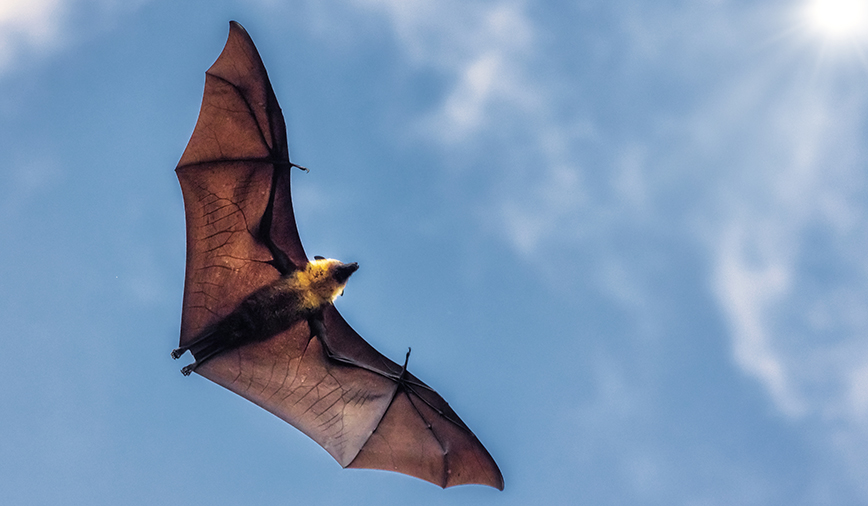As I got ready to head out for a walk Sunday evening, I made the usual preparations. Jacket? Check. Waterproof boots? Check. Hat? Of course. Bat detector?
Huh?
Not in a million years would I have thought to bring out, on March 2nd, the electronic gadget I use each summer to detect the presence of flying mammals. But oh how I wish I had!
The time was around 6:30 p.m.; the place, a trail along the Fox River. A hundred or so Canada geese were making quite a racket on the water, honking and carrying on in celebration of surviving another day. That’s when I saw it: a lone bat, fluttering through the air.
At first I thought the moving object was a goose, far in the distance. But then two things happened. My eyes readjusted, and the little critter obligingly returned for another pass.
Sure enough, it was a bat all right, and it looked to be foraging for insects. Its wavering flight, quite different from the straighter, more-direct flight of a bird, was unmistakable. Plus, it was flying at a time when most birds are tucked safely away in their night-time roosts. I stood, mesmerized, for about five minutes as the little guy (or gal) flitted back and forth
I’m no bat expert, but if I had to make a guess I’d say I was watching a red bat, one of our area’s most common woodland-dwelling bats. Red bats differ from the little brown bats and big brown bats also found here in a several ways. For one, they are a bit larger than the brown bats, with an average body length of about 4 inches and average weight of around 10 grams—the same as 2 nickels.
Second, red bats tend to live singly, and favor wooded areas. Brown bats are what we refer to as “colonial,” meaning that each summer females gather together to form maternity colonies for raising young. Ever find bats in your house? Chances are very good they were brown bats, and slim to none that they were red ones.
For another clue about red bats, all you need to do is decipher their scientific name, Lasiurus borealis. Any students of the Greek language out there? Lasiurus, loosely translated, means shaggy tail. Borealis means northern. So what we’ve got is a bat with a hairy patootie (scientists call it the uropatagium, and it’s actually a flap of skin that runs between the hind legs) that helps keep it warm in the northern latitudes where it lives.
But what the heck was this bat doing out on March 2nd? Maybe, just maybe, if I’d had my bat detector with me, we’d know. The detector is an electronic device that senses the ultrasonic shouts bats make when they’re echolocating—using sound to locate objects—then scales the high-frequency sound downward to a range our human ears can hear.
When bats hone in on a prey item, say, a juicy moth, they emit sounds faster and faster; on the bat detector, it sounds sort of like “click…click…click…click..click..click..clickclickclickclick.” When the chase ends and the insect is captured, the resulting sound translates as a harsh “zzzzt,” also called a feeding buzz.
Was there a buzz Sunday evening? We’ll never know. Research indicates that some bats do fly periodically during winter, sometimes eating, sometimes drinking, sometimes just flying. But without the bat detector, it’s a tough call. Making any guess at all would be, literally, just a shot in the dark.
One thing’s for sure: Seeing a bat on a warm winter evening sure gave me a buzz of a most agreeable sort. You can bet that the next seasonably warm night we have, I’ll be out along the river, bat detector in hand. Same bat-time, tuned in—with luck—to the same bat’s channel.
—
Speaking of creatures of the night…the St. Charles Park District will be hosting two programs that focus on those other famous nocturnal flyers, owls. This Saturday, March 8, is Owl Pellet Dissection. Geared for youth ages 6-12, the program runs from 9-10:30 a.m. Fee is $10 for St. Charles residents, $15 for non-residents. Refer to bar code 3063 when registering.
The following Saturday, March 15, from 9-11:30 a.m., is Great Horned Morning. This adult-level program explores the life cycle of the great horned owl and will include a car-caravan trip to observe an active owl nest. Fee is $5 for residents and non-residents alike. Refer to bar code 3194 when registering.
Pam Otto works for the St. Charles Park District and can be reached at potto@stcparks.org or 630-513-4346. For more information on how to register for any of the above programs, please call the Pottawatomie Community Center at 630-513-6200.

